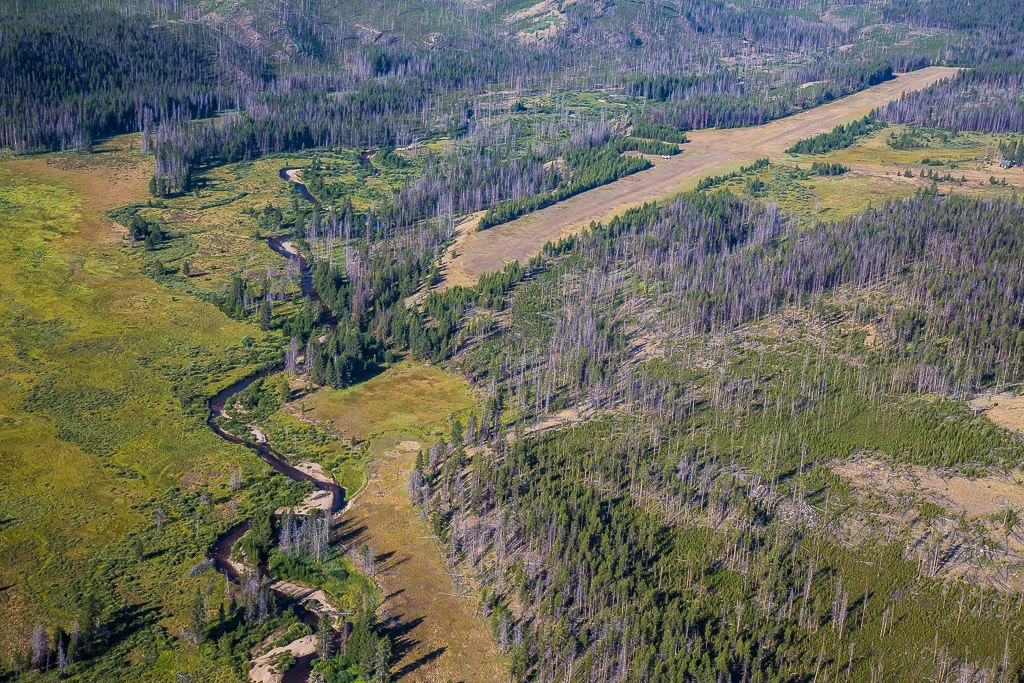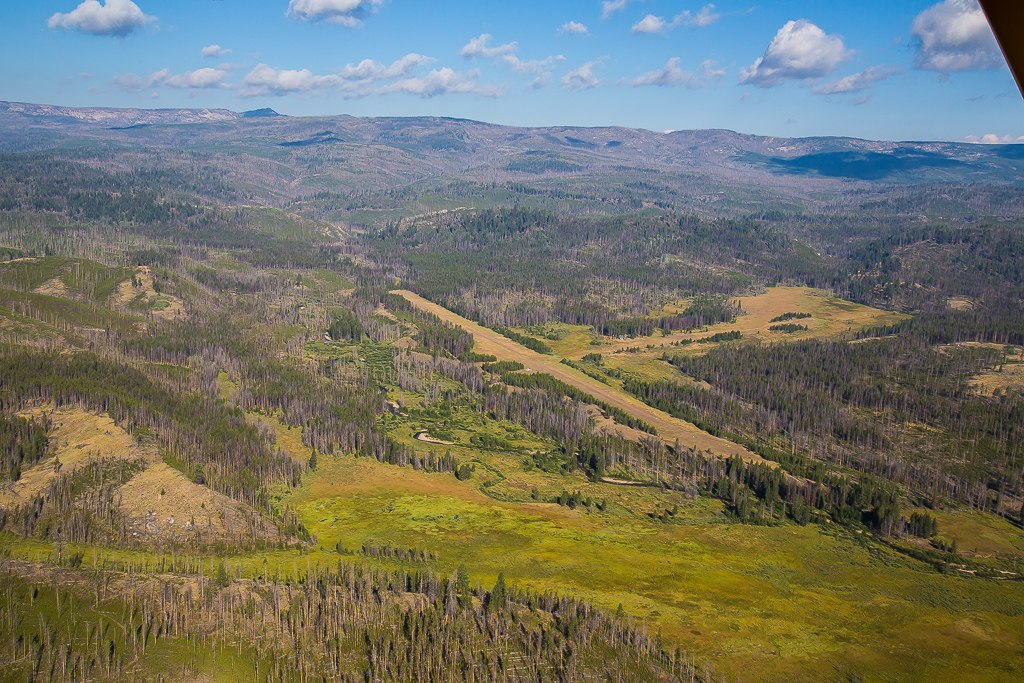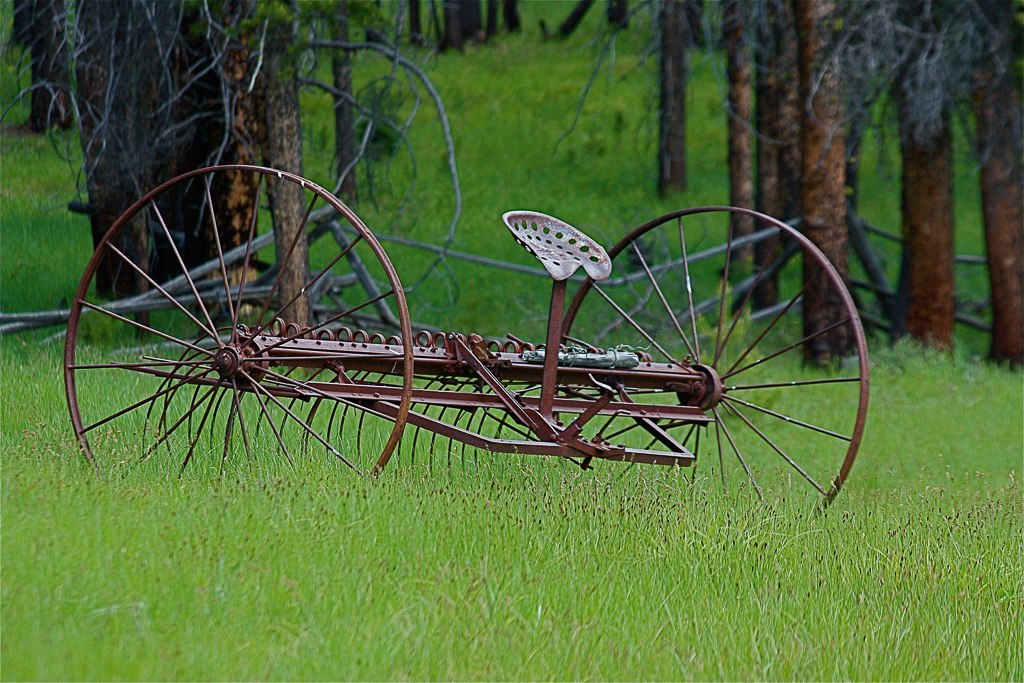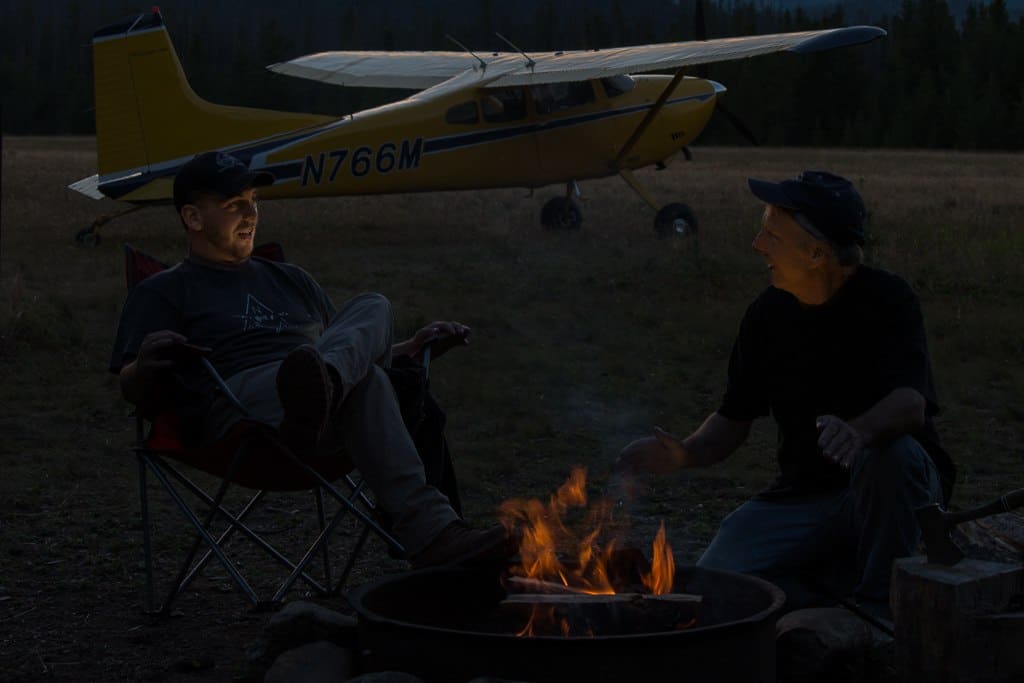Flying Idaho Backcountry: Chamberlain Basin
People learn to fly for a variety of reasons. Some simply want to be in the air with the freedom of flying like a bird, others may be intrigued with the physics of flight and thrive on challenge and learning new skills. I know of some pilots who are only interested in aerobatics, and love the thrill of extreme and unusual attitudes. I see some who spend 90 percent of their time in the pattern, doing touch and goes. Most who fly probably enjoy the simple idea of traveling from one place to another with the speed and style only an aircraft is capable of. Some pilots manipulate nearly all their recreation time around flying to the most unique and exotic locations they can find, where the airplane may be the only means of access. They look for locations that are beautiful, challenging and fun, where the experience is unlike that of any other type of travel. These are the kind of places I find reasons to go.
Hangar talk topics have a broad range and these conversations always include discussions about favorite flying locations. These networking circles are the way that the best information is passed on in the aviation world. 20 years ago, in one of these BS sessions I found out about a place I was immediately drawn to. The mental images I processed created a scene that included all the elements of my kind of location. I grew up in a rural area and have always loved the wilderness. I like remote and isolated places.
So when Chamberlain Basin in Central Idaho was introduced to me, I started dreaming of flying an airplane to a place I could camp, fish and explore. And where no automobile could bring the masses of people that flock to places like this. The Frank Church River of No Return Wilderness Area in central Idaho is just such a place, and more. The adjoining Gospel Hump and Selway-Bitterroot Wilderness areas combine to be a huge protected area in majestic mountains where the Salmon River and its forks have cut deep canyon walls and beautiful vistas. The swift current of the rivers make it a popular destination for white water rafting. Steelhead and trout fishing are also favorite activities, as well as hunting of bear, elk, moose, deer, cougar and Big Horn sheep. While the designation as a wilderness area in the United States generally prohibit the use of motorized machinery, the use of Jet boats on the Salmon and aircraft on the landing strips are allowed, as these uses were “grandfathered” in due to necessity for access and because they became a primary form of transportation before the wilderness was designated. Not all the property is wilderness area; there is a nice mix of private property where folks from all over the world come to stay in remote lodges on private land.
I know a lot has been written about Idaho by others who have much greater literary skills than I. In spite of this weakness I almost feel compelled to share the passionate feelings I have about this place. I won’t try to impress anyone with a bunch of facts and figures, but will attempt to share some of the memories, emotions and thoughts that have come to me from my experiences here.
When I first learned about this aviator’s paradise in Idaho I began planning my first trip. I didn’t have an aircraft available to me that seemed acceptable for this type of flying. I would need something with adequate power, speed and weight carrying capacity. But that didn’t stop me from dreaming and planning. Somehow I knew I would figure out a way to get there.
As the dream festered I masterminded a scheme that would open the door for my introduction to the backcountry. I was at the time a freshly minted flight instructor and was working with a couple guys who had purchased an old 182. They were pilots, one who hadn’t flown for years and the other a recently licensed private pilot. The 182 would work nicely for the strips I had in mind. It has a good useful load, range and power so I suggested to one of them that we should go to this area I had heard about. I didn’t have to do any selling on the idea and plans were made that moment. Johnson Creek, a strip I knew would feel challenging but not too difficult would be our first place. I knew I would be in the right seat, which was not my first choice, but nonetheless I was excited to have the chance to experience this trip.
We landed and camped by the airplane and we still talk about that trip today. We also flew to Indian Creek, Garden Valley and Smiley Creek. My life would be different as a result of that trip. I became obsessed with going back and each year, except for one or two, I have returned, exploring new places and I find myself itching to go back no matter how long it has been since my last trip.
Last week Corey and I managed to carve out a couple days from our schedules and we found ourselves headed north to our favorite place loaded with food, camping and fishing gear. Chamberlain Basin is situated a bit higher than most of the Idaho strips at 5765 ft elevation. 4100 feet of runway gives plenty of room for most any single engine aircraft with reasonable power. It slopes upward when landing to the west and is smooth, except for a few Gopher holes. I have seen these bigger holes damage a few propellers over the years, so unless you fly a tail wheel it’s best to shut down and pull the aircraft by hand after landing, or have a helper scout the area for holes. The entire area is surrounded by forest with tall pines, nice meadows and a beautiful creek that winds its way down the valley. It’s only a short little walk from the campsite to the creek. The smell of the pines, sounds of the creek, birds chirping and stunning scenery make this little piece of Heaven perfect. The only access here is by aircraft, horseback or hiking.
The Forest Service maintains a ranger and a trail crew based at Chamberlain. These are often friendly younger people who love the outdoors and we find ourselves having pleasant conversation with them when they are not out on trail duty. They love this place as much as I do. This time a young man arrived at our camp dragging a sled like container full of dry wood he generously left for our campfire. It had been raining the previous days and we were struggling to keep the fire going with wet wood.
Corey and I have been at this airstrip together probably 20 times since he was a small child. We have forged memories that will remain with me and him forever. Each time we have come we have found something unique, something different, something special.
One time it was wolves. We saw 11 of them in the meadow. Young pups romped around the field playing carelessly while the adults sat unaffected nearby. The apparent alpha male stood guard at the edge of the trees. After a awhile he barked out what seemed to be orders to the others and they all marched single file into the trees where they began to howl. It was piercing loud and uncomfortably eerie and it sent shivers up my spine. They had killed a cow moose the night before that we found half eaten in the stream. Wolves are very controversial in the area and locals hate them. They feel they have all but destroyed the hunting industry. The battle will go on, but for us, it was an impressive view of nature and instilled a solemn respect for these animals. Corey and I both talk about this experience whenever we describe the area to anyone.
We always like to fish the stream that runs next to the airstrip. The fish are plentiful, but tiny. At times we have caught fish on about every third cast or so with our fly rods, the biggest being about 6 inches long. We use dry flies and its fun to watch the fish come up and take the fly. Yeah, I know real fisherman go for big fish, but we have fun. In fact one time we had a contest, which of us could land the smallest fish. Corey ended up winning with a little brook trout not more than 2 inches long.
Twice now, we have found salmon in the creek. These fish are not tiny; in fact, they often are close to 30 inches long. I watch them for hours, fascinated. They are in bad shape with decomposing bodies by the time they finally arrive here, all the way from the ocean. If you have never learned about the life cycle of these amazing creatures you should. You will be amazed when you do. These fish come back to the very spot where they hatched to spawn and in late July and August they can easily be seen from a nice vantage point near one of the campsites. The males are aggressively chasing off competition for the best spots in gravel beds where the females roll on their side and fan out a depression where the eggs are laid. The fish soon die after the process and offer up their body as nutrients for other animal life. I don’t know how many miles these salmon have come from the ocean but it is a significant distance and may even approach 2000 miles. The fish stop eating when they enter fresh water and begin living off stored body fat. By the time they get to their spawning area they have none left and their bodies are even beginning to decompose. By now they aren’t very strong and they are not as beautiful as they once were. I consider the opportunity to witness this miracle in nature to be a real privilege. The salmon have only started showing back up after years of not being able to make the trip due to the man made dams that have stopped their journey. Now with the fish ladders and the ecologist efforts the fish are again able to be in these waters.
Almost each time we camp at Chamberlain we hike the mile or two over to an old homestead called “Stonebreaker”. This place has a unique history and is now owned by the fish and game. There is a rustic cabin and a few little out cabins that are still in occasional use today. An old historic barn still stands, or leans, and is fun to wander around observing the old farm implements and antique machinery that litter the grounds. Old tools and traps hang on the walls offering a nostalgic view into the past. On one occasion we found a cow moose living inside the barn. We gave her a lot of space, being nervous of what she might do if we spooked her.
My mind wanders as I consider the people who actually lived in this wilderness environment a hundred years ago. I wonder how they lived, what they did and how they survived. I think about the long and cold winters with deep snow, and how self sufficient and hearty these people must have been.
Something I always enjoy about camping is cooking over coals and making good food. I pack a small, lightweight aluminum Dutch oven and dream up combinations of ingredients that sound appetizing. They always taste good to me, but it could be we are just starving by the time its ready. There are a lot of recipes available for cooking in a Dutch ovens but I have found that you almost cannot make a mistake. Nearly whatever you put in and cook for one hour is good. I also take a small lightweight grill I can prop up over the coals to cook steaks or fish on. Food cooked over a campfire always tastes great.
It’s not uncommon for afternoon for evening thunderstorms to build up in these mountains. The deafening crack of thunder and the blinding bolts of lightning followed by drenching rain showers are threatening; yet are pleasant and inspiring. The gentle sounds of raindrops at night on the tent stir unforgettable memories. When skies clear the air becomes so clear that it seems as though you can see forever into the universe and the brilliance of the stars and moon is unbelievable. When these events are shared with friends or family it seems to really deepen the relationship and I believe these are times when Corey and I have moved to more than that just of parent/child to greater depths of friendship. We both have enjoyed lots of meaningful moments, enhanced by the common kinship we feel toward the trusted friend that rests nearby, ready to safely carry us wherever we ask it to. No one can tell me an airplane does not have a spirit.
Normally, we plan to fly off for breakfast at least one morning during our stay. Even though we are camping in a wilderness area we are not more than 10 or 15 minutes by air to somewhere we can fly to for a good meal. It’s not that we need the food, as much as it is part of our adventure. The Root Ranch is only a few minutes to the east and is a wonderful privately owned lodge where you could spend a night or stop by for some food. It’s a fun approach with the strip at the bottom of a canyon and is stunning beautiful. We have always been welcomed for a hearty breakfast and a nice visit.
Last week we flew the short 16 miles from Chamberlain to a tiny place called Dixie Town where there are a handful cabins and a hunting lodge. A five-minute walk took us downtown where we had breakfast at the “Silver Spur Lodge”. When we arrived, the question is “how many?” and what comes to the table is plenty of what is on the stove. The little town dates back to the mid 1800s when gold was discovered in the area. A handful of people live here year round and a number more have recreational cabins they visit occasionally. The approach into the little strip appeared to be shorter and more confined than it really was. Consequently I got two or three landings from this one approach as I dribbled my airplane to a stop. It was a fun place to go and I will return again when I am in the area.
There are a number of fly in locations where you can get breakfast or stay overnight throughout this region. It’s fun to explore these places and meet the nice people who run them. They are dedicated, hard working individuals who make our experience a memory we treasure. I have always found the common thread of generosity, kindness and a warm welcome. Each airstrip is unique in history, topography and scenery.
Flying into these strips is never a simple standard approach with a nice rectangular pattern like we have at our home airport. Hazards like wind, animals and surface conditions must be assessed. Obstructions in the form of mountains, trees and rocks make each place unique. When the descent below the surrounding terrain is made very often the landing strip is completely hidden and your pilot skills are working overtime assessing and judging where you should be and when you should turn or descend. At many places you only finally see the touchdown zone on short final. The challenge of finding an appropriate way through an approach and landing is a thrill, while also sometimes laced with anxiety. This is what reminds you that you have a heart beat. After landing and exiting the airplane I always find myself exhilarated, hardly able to believe I just experienced what I did, and sometimes, just a little weak in the knees.
I always try to be finished with my flying by 10 or 11 am and be back on the ground at camp before the winds start picking up and the temperature rises. I don’t fly the backcountry every day for a living and have to deal with strange air currents or deal with the every day hazards of flying off dirt strips in the mountains. My skill and judgment in these mountains will never match that of those who do. This is recreational flying for me and I will take every advantage of calm and cool conditions. My airplane has 300 horsepower and still I have found myself in areas where climb rates and performance levels seem uncomfortably low. I may be considered a little over conservative at times but I respect the unforgiving nature of mountains and weather. Higher density altitude and unpredictable winds that occur later in the day raise the risk level dramatically. I like to have odds in my favor.
It’s a real privilege to be in this area. It’s a rugged and unforgiving place, and yet it is a comfortable, peaceful and inviting place. I am drawn to it and hardly a day goes by when I don’t think about going back. Almost every time I look at my Skywagon I think of the amazing places it has taken me. Idaho is top of the list and Chamberlain Basin, is one of my favorites. The solitude, beauty, history, challenge and friendships appeal to me. We have created many friendships through the years with people we have met in the backcountry. One aviator, a Navy F18 pilot, flew his Maule to the back country and landed at Chamberlain when we were camped there. As a conversation developed, this fellow claimed that flying into these strips in the backcountry was more exhilarating than landing the F18 on a carrier. I can hardly believe that to be true but it is an example of how others see this area. The people we have met and experiences we have enjoyed throughout the years in the Idaho backcountry have affected both Corey and I.
Late at night I often wander off to the center of the landing strip and look up at the stars. As I do so the awesomeness of the experience always hits me and I sense a deep emotional feeling that is hard to describe. I feel a sense of gratitude for how lucky I am to have this experience. I feel like I belong here and I am humbled to be one of the few on this planet who have the opportunity to do something as unique as this.
I try to explain the feeling to those who don’t fly, but they don’t seem to understand. Even pilots, often cannot imagine that this is something they could do. Flying a plane is an awesome opportunity and requires ongoing effort to keep current and sharp. Flying in the backcountry raises the bar another level and requires even a higher degree of skill and precision. But that doesn’t mean it’s impossible or dangerous for a lower time pilot to participate. If you fall into that category, my suggestion would be to first perfect your skills at your home airport. Learn how to effectively do short field and soft field landings until you can consistently land on your spot. Get to the point you can fly the airplane in any attitude at a constant airspeed. Learn to fly at a comfortable approach speed with half flaps without staring at the instruments. Load the airplane up to its gross weight and find out how it flies. Fly in the wind and learn to handle it. My experience has shown me that I can do a great job at my home airport with a lightly loaded airplane and no wind. But put people, fuel and camping gear in the airplane and go to unfamiliar surroundings with trees and other obstructions around and it is a different story. Add high temperature and risk goes even higher. Once you are very competent with the basic skills and can do them without thinking much about it find a good instructor who will help you. Have him work with you on some easy unobstructed turf or gravel strips and then as skills improve, graduate to more confined areas. When you, and your instructor feel that you are competent, do some solo in the same areas and slowly work yourself up to become comfortable in this type of flying. When you are ready, and you will know, take a friend with you and go where you know you have the skills to go. Fly in good weather, early in the morning or late in the day when the conditions are optimum. Learn what your personal limitations are and stay within those boundaries.
As with any other type of flying it takes time and effort to develop the ability, judgment and knowledge base to be safe in the backcountry. I have never seen a “natural” instrument pilot or “natural” aerobatic pilot. Everyone has to learn, some may pick it up quicker than others and some may have more innate talent than others, but serious practice, study and concentration are required to learn what is necessary to be safe, no matter who you are. My advice is to decide to never stop becoming better, never think you know it already and never be so prideful you can not accept the advice of others.
Hope to see you at the Chamberlain Basin.
Images from Google – of Chamberlain Basin
[optin-monster-shortcode id=”wwcyfbdjs9-post”]







